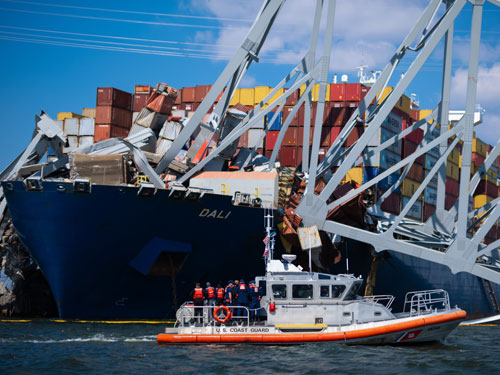
Credit: USCG
During the final week of March 2024, a variety of federal, state, and local agencies began the monumental task of salvage operations in the aftermath of the collapse of the Francis Scott Key bridge.
U.S. Army Corps of Engineers (USACE), Baltimore District activated its Emergency Operations Center on March 26th.
USACE will leverage its pool of engineering, construction, contracting, and operations specialists to provide support to local, state and federal agencies following the collapse of the Francis Scott Key Bridge.
In accordance with federal authorities, USACE is leading the effort to clear the Federal channel as part of the larger interagency recovery effort.
USACE Baltimore District operates and maintains more than 290 miles of federal navigable channels within the Susquehanna River watershed, including the Fort McHenry Channel.
As of March 27, USACE was providing:
Certified underwater assessment capabilities by Structural Professional Engineers, Remotely Operated Vehicle and sonar;
Structural Engineering support, including certified bridge safety inspectors and urban search and rescue structural technical specialists;
Waterway debris management, led by USACE debris removal vessel REYNOLDS, which patrols the waters of the Baltimore Harbor and Patapsco River for drift and debris that could be hazardous to navigation; Hydrographic and topographic surveying via the CATLETT, a 61-foot survey vessel that actively supports the Baltimore District’s Navigation Branch.
Additional support from USACE is available to join the response:
Additional USACE vessels are prepared to join efforts as needed for waterway debris management, led by USACE debris removal vessel REYNOLDS;
Two survey vessels from USACE, Philadelphia District, H.R. SPIES and the DAUNTLESS, are available to support;
USACE dive safety experts from the Philadelphia, Buffalo, and New England Districts are expected to join the response effort.
On March 27th, a Unified Command and Joint Information Center was established in Baltimore to coordinate response and disseminate information for the Francis Scott Key Bridge collapse, salvage operations, and other work.
Prior to beginning the salvage operation, dive operations and vehicle recovery were paused due to hazardous conditions caused by the submerged wreckage and debris.
The Unified Command has established a 2000-yard Safety Zone for the M/V Dali recovery efforts. The safety zone is enforced for the protection of personnel, vessels, and the marine environment from the potential hazards associated with salvage work.
An array of specialized heavy equipment was brought in to support salvage work at the bridge collapse site.
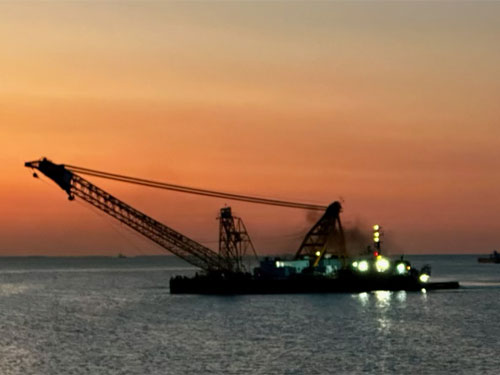
Credit: USCG
The 1000-ton capacity floating boomable shearleg Chesapeake 1000 crane barge arrived on March 29th. The vessel is capable of performing heavy salvage, demolition, and other tasks.
On Saturday, March 30, 2024, the Unified Command commenced cutting operations to remove wreckage from the Francis Scott Key Bridge collapse.
To expedite salvage operations, Unified Command plans to dispatch an additional seven cranes, ten tugs, and nine barges to the site.
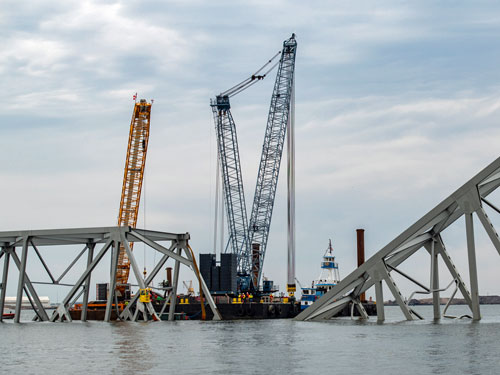
Two crane barges, a 650-ton crane and a 330-ton crane, are tasked with lifting wreckage from the bridge. At Tradepoint Atlantic, a 230-ton land-based crane will offload and process the wreckage to be taken to a disposal site.
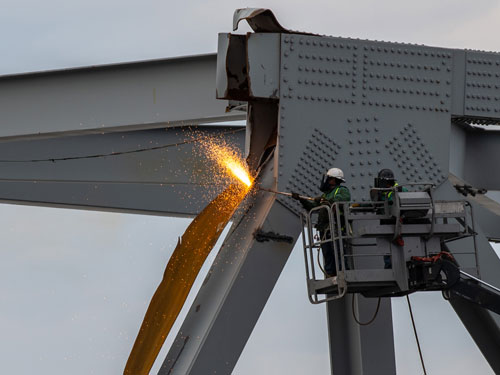
Credit: USCG
On March 30th, specialized demolition crews began cutting the top portion of the north side of the collapsed bridge truss.
In addition to local tugboats, tugs EZRA SOL (IMO 8976607) and KATAN (8852710) were on scene as well as utility vessel NORTHSTAR CHALLENGER (IMO 8940581).
On Sunday, March 31, Unified Command announced that the Captain of the Port (COTP) was preparing to establish a temporary alternate channel on the northeast side of the main channel in the vicinity of the Francis Scott Key Bridge for commercially essential vessels.
This action is part of a phased approach to opening the main channel. The temporary channel will be marked with government lighted aids to navigation and will have a controlling depth of 11 feet, a 264-foot horizontal clearance, and vertical clearance 96 feet.
The current 2,000-yard safety zone around the Francis Scott Key Bridge remains in effect and is intended to protect personnel, vessels, and the marine environment. No vessel or person will be permitted to enter the safety zone without obtaining permission from the COTP or a designated representative.
The Key Bridge Response 2024 Unified Command includes the:
U.S. Coast Guard
U.S. Army Corps of Engineers
Maryland Department of the Environment
Maryland Transportation Authority
Witt O’Brien’s representing Synergy Marine
Maryland State Police
A website with incident response information can be found at the following URL:
https://www.keybridgeresponse2024.com
On March 27th, two bodies were recovered from the collapse site. A third body was recovered on April 5th. On April 14th, a forth body was recovered from the site. The 5th body was recovered on May 1st and the final body was recovered on May 7th.
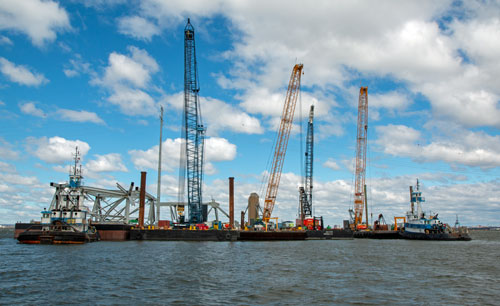
During the first week of April, demolition work included the removal of a 156-ton piece of Span 19 outside of the navigational channel, which was hoisted and loaded onto a barge for future disposal. Unified Command that during the week, vessel traffic increased in the temporary alternate channel.
On April 4th, USACE Baltimore District announced that, after detailed studies and engineering assessments by local, state and federal organizations, in collaboration with industry partners, USACE expects to open a limited access channel 280 feet wide and 35 feet deep, to the Port of Baltimore by the end of April.
The new channel will support one-way traffic in and out of the Port of Baltimore for barge container service and some roll on/roll off vessels that move automobiles and farm equipment to and from the port.
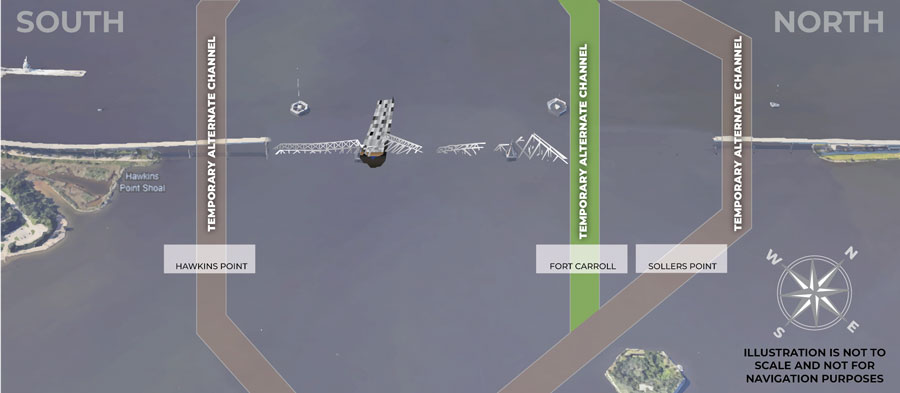
Credit: Key Bridge Response 2024 Unified Command
On April 19th, Unified Command announced that the Captain of the Port has established the Fort Carroll Temporary Alternate Channel, which is on the northeast side of the main channel in the vicinity of the Francis Scott Key Bridge and will provide limited access for commercially essential vessels.
The Fort Carroll Temporary Alternate Channel, depicted in green, has a controlling depth of 20 feet, a 300-foot horizontal clearance, and a vertical clearance of 135 feet, and will facilitate additional commercially essential vessel traffic through the port of Baltimore.
The opening of the Fort Carroll Temporary Alternate Channel is part of a phased approach to opening the main channel. The third temporary channel is marked with government-lighted aids to navigation and will be limited to transit at the discretion of the COTP.
The channel has a controlling depth of 20 feet, a 300-foot horizontal clearance, and a vertical clearance of 135 feet, according to Unified Command.
Related Information
Port of Baltimore Temporary Alternate Channel
M/V Dali Collision – Francis Scott Key Bridge Collapse NTSB Investigation